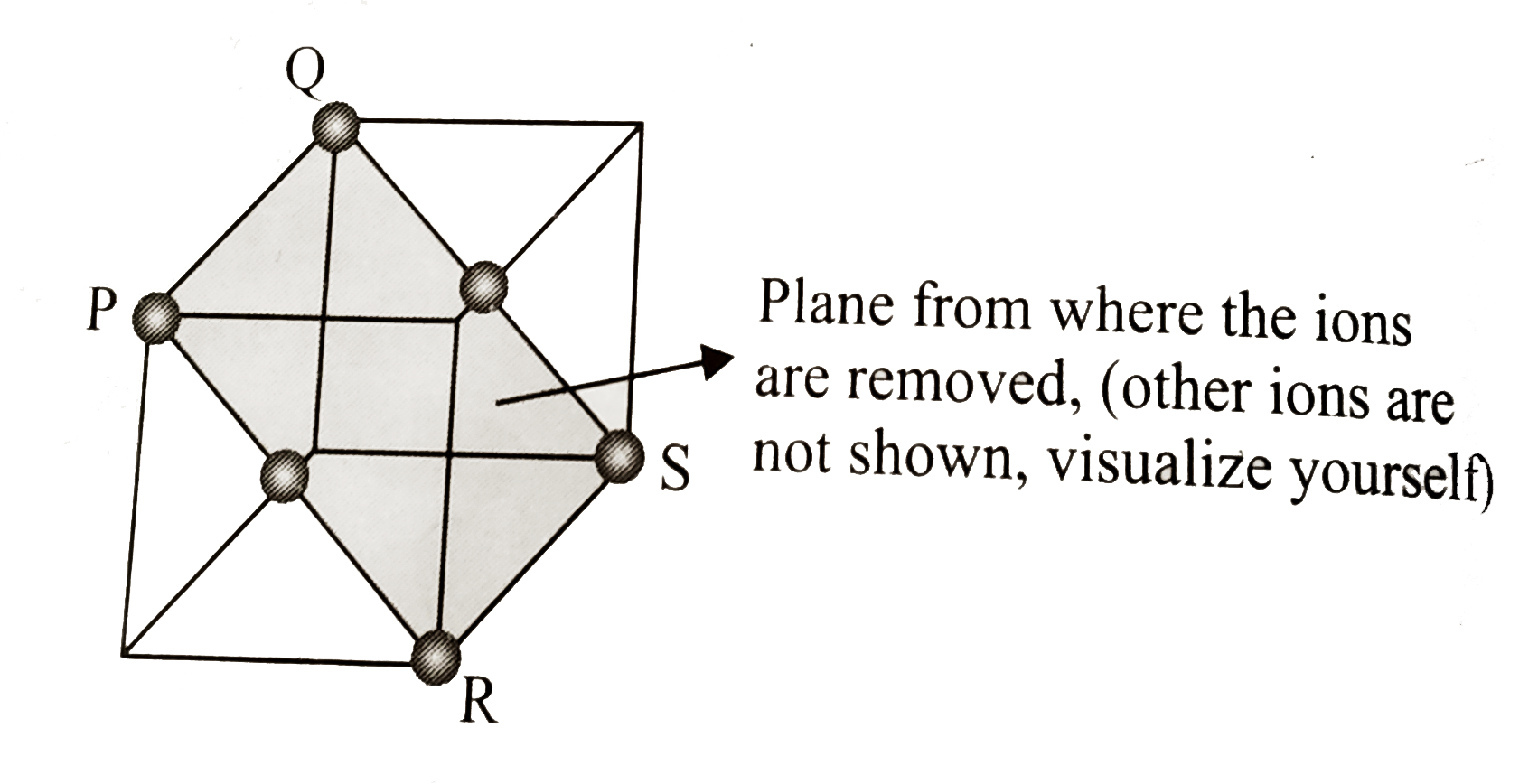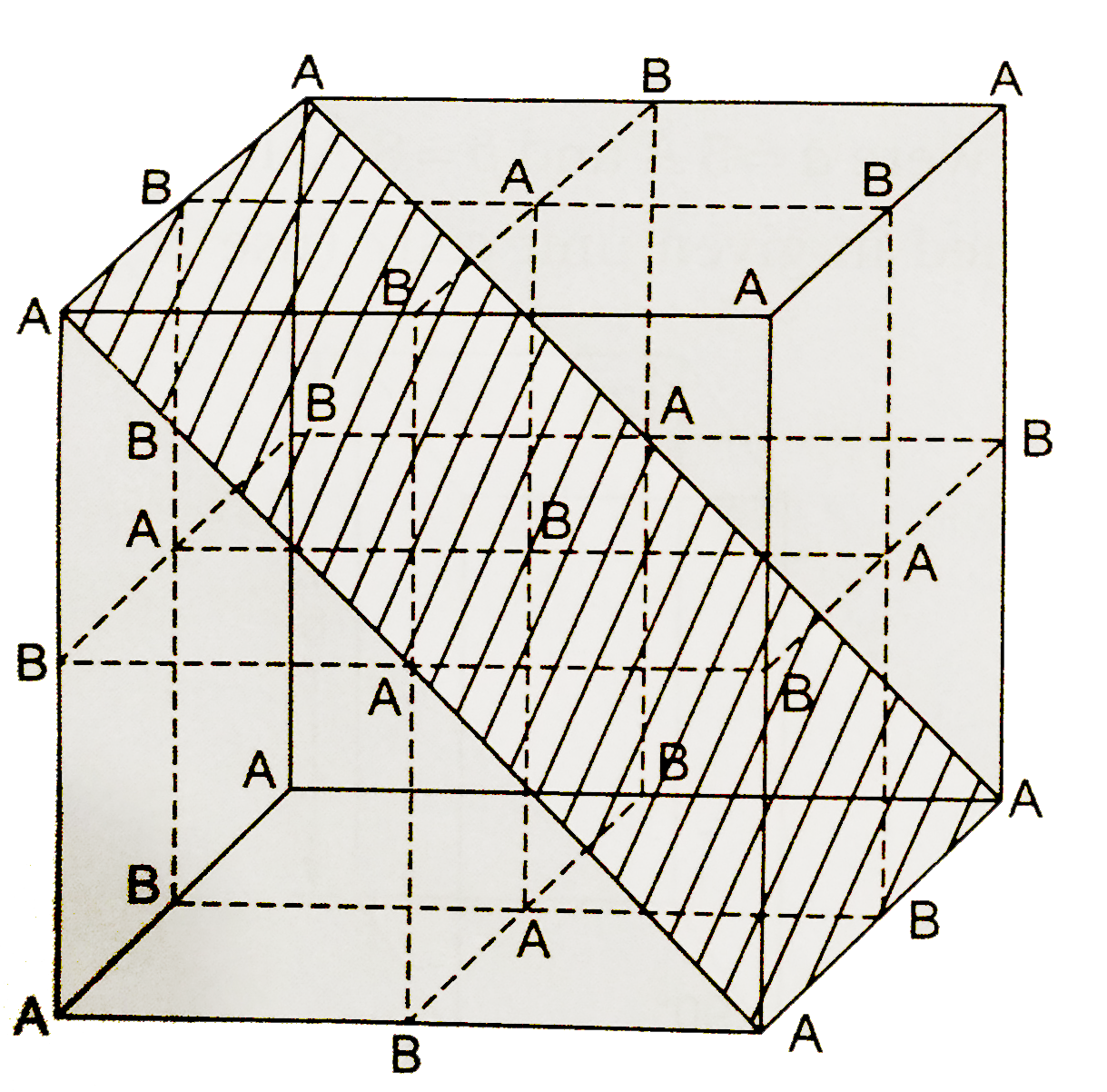A compound made of particles A, B, and C forms p lattice. Ions A are at lattice points, B occupy TVsC occupy OVs. If all the ions along one of the edge axis are removed, then formula of the compound is
A3.75B8C3.75
A3.75B4C8
A4B8C3.75
A4B3.75C8
The correct Answer is:A
To solve the problem step-by-step, we need to analyze the information given about the compound made of particles A, B, and C that forms a CCP (cubic close-packed) lattice.
Step 1: Determine the number of A ions
In a CCP lattice:
- A ions are located at the lattice points, which include the corners and face centers.
- There are 8 corner atoms, each contributing 18 to the unit cell, and 6 face-centered atoms, each contributing 12.
Calculating the effective number of A ions:
Number of A ions=(8×18)+(6×12)=1+3=4
Step 2: Determine the number of B ions
B ions occupy the tetrahedral voids. In a CCP lattice, the number of tetrahedral voids is twice the number of octahedral voids. The number of octahedral voids is equal to the number of atoms in the unit cell (which is 4 for A).
Calculating the number of B ions:
Number of B ions=2×Number of octahedral voids=2×4=8
Step 3: Determine the number of C ions
C ions occupy the octahedral voids. As established, the number of octahedral voids is equal to the number of effective atoms in the unit cell (which is 4 for A).
Calculating the number of C ions:
Number of C ions=Number of octahedral voids=4
Step 4: Removing ions along one edge axis
When all ions along one edge axis are removed:
- From the corners, 2 A ions are removed (each corner contributes 18, so 2×18=14).
- From the octahedral voids, 1 C ion is removed (each octahedral void contributes 14, so 1×14=14).
- The number of B ions remains unchanged as they do not occupy the edge.
Step 5: Calculate the remaining number of ions
After the removal:
- Remaining A ions:
Remaining A ions=4−14=164−14=154
- Remaining B ions:
Remaining B ions=8
- Remaining C ions:
Remaining C ions=4−14=164−14=154
Step 6: Write the formula of the compound
The formula of the compound can be expressed in terms of the remaining ions:
Formula=A154B8C154
To express this in whole numbers, we can multiply through by 4:
Formula=A15B32C15
Final Answer
The formula of the compound after removing the ions along one edge axis is:
Formula=A15B32C15
In a CCP lattice:
- A ions are located at the lattice points, which include the corners and face centers.
- There are 8 corner atoms, each contributing 18 to the unit cell, and 6 face-centered atoms, each contributing 12.
Number of A ions=(8×18)+(6×12)=1+3=4
B ions occupy the tetrahedral voids. In a CCP lattice, the number of tetrahedral voids is twice the number of octahedral voids. The number of octahedral voids is equal to the number of atoms in the unit cell (which is 4 for A).
Number of B ions=2×Number of octahedral voids=2×4=8
C ions occupy the octahedral voids. As established, the number of octahedral voids is equal to the number of effective atoms in the unit cell (which is 4 for A).
Number of C ions=Number of octahedral voids=4
When all ions along one edge axis are removed:
- From the corners, 2 A ions are removed (each corner contributes 18, so 2×18=14).
- From the octahedral voids, 1 C ion is removed (each octahedral void contributes 14, so 1×14=14).
- The number of B ions remains unchanged as they do not occupy the edge.
After the removal:
- Remaining A ions:
Remaining A ions=4−14=164−14=154
- Remaining B ions:
Remaining B ions=8
- Remaining C ions:
Remaining C ions=4−14=164−14=154
The formula of the compound can be expressed in terms of the remaining ions:
Formula=A154B8C154
Formula=A15B32C15
The formula of the compound after removing the ions along one edge axis is:
Formula=A15B32C15
Topper's Solved these Questions
- SOLID STATEBOOK - CENGAGE CHEMISTRY ENGLISHCHAPTER - SOLID STATEEXERCISE - Solved Examples
13 Videos
- SOLID STATEBOOK - CENGAGE CHEMISTRY ENGLISHCHAPTER - SOLID STATEEXERCISE - Exercises (Linked Comprehension)
13 Videos
- REDUCTION AND OXIDATION REACTION OF ORGANIC COMPOUNDSBOOK - CENGAGE CHEMISTRY ENGLISHCHAPTER - REDUCTION AND OXIDATION REACTION OF ORGANIC COMPOUNDSEXERCISE - SUBJECTIVE TYPE
4 Videos
- SOLUTIONSBOOK - CENGAGE CHEMISTRY ENGLISHCHAPTER - SOLUTIONSEXERCISE - Ex 2.3 (Objective)
9 Videos
Similar Questions
A compound made of particles A, B, and C forms p lattice. In the lattice, ions A occupy the lattice points and ions B and C occuphy the alternate TVs. If all the ions along one of the body diagonals are removed, then formula of the compound is
View SolutionA compound made of particles A and B. A forms fcc packing and B occupies all the OVs. If all the particles along the plane as shown in the figure below are removeed, then the simplest formula of the compound is

View SolutionA2B has antifluorite structure (B forms FCC lattice and A occupies tetrahedral voids).If all ions along any one body diagonal are removed, then new formula of compound will be :
View SolutionA compound formed by elements A and B crystallises as FCC lattice. If A is present at the lattice points of unit cell and B occupy half of tetrahedral voids as well as one fourth of octahedral voids then the formula of the compound will be
View SolutionA crystal is made of particles X,Y and Z.X form fcc packing . Y occupies all the octahedral void of X and Z occupies all the tetrahedral voids of X . If all the particles along one body diagonal are removed then the formula of the crystal would be:
View SolutionA compound of A and B crystallizes in a cubic lattice in which A atoms occupy the lattice points at the corners of a cube and two atoms of B occupy the center of each of the cube faces. What is the formula of this compound?
View SolutionA crystal is made of particles A and B . From fcc packing and B occupies all the octahedral voids . If all the particle along the plane as shown in figure are removed , then, the formula of the crystal would be :

View SolutionA crystal is made of particles X and Y.X form fcc packing and Y occupies all the octahedral voids . If all the particles along one body diagonal are removed then the formula of the crystal would de :
View SolutionIn a solid, oxide ions are arrnged in ccp, cations A occupy A occupy (18)th of the tetrahedral voids and cation B occupy (14)th of the octahedral voids. The formula of the compound is:
View SolutionIn a ccp structure of X atoms, Y atoms occupy all the octahedral holes. If 2X atom are removed from corners and replaced by Z, then the formula of the compound will be
View Solution
